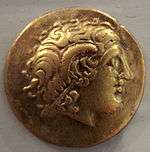Lexovii
The Lexovii (Ληξόβιοι, Strabo; Ληξούβιοι, Ptol. ii. 8. § 2), were a Gallic tribe dwelling immediately west of the mouth of the Seine, around present-day Lisieux.
When the Veneti and their neighbours were preparing for Julius Caesar's attack (56 BC), they applied for help to the Osismii, Lexovii, Namnetes, and others. (B. G. iii. 9, 11.)
Name
They are mentioned as Lexovii by Caesar (mid-1st c. BC),[1] as Lēxobíous (Ληξοβίους) and Lēxooúioi (Ληξοούιοι) by Strabo (early 1st c. AD),[2] as Lexovios by Pliny (1st c. AD),[3] and as Lēxoubíōn (Ληξουβίων) and Lēxoúbioi (Ληξούβιοι) by Ptolemy (2nd c. AD).[4][5]
The etymology of the name Lexovii is uncertain. It may stem from the Gaulish root lexsouio- ('sloped, lame'; compare with Old Irish losc, 'lame'). An exact parallel has been highlighted with the Welsh llechwedd ('slope, inclination'; from an earlier *lexsouíiā).[6]
The city of Lisieux, attested as civitas Lexoviorum ('civitas of the Lexovii', Loxovias in 614, Lisiue in 1024), is named after the Gaulish tribe.[7]
History
Caesar sent Quintus Titurius Sabinus against the Unelli, Curiosolites, and Lexovii, to prevent their joining the Veneti. A few days after Sabinus reached the country of the Unelli, the Aulerci Eburovices and the Lexovii murdered their council or senate, as Caesar calls it, because they were against the war; and they joined Viridovix, the chief of the Unelli. The Gallic confederates were defeated by Sabinus, and compelled to surrender. (B. G. iii. 17-19.) The Lexovii took part in the great rising of the Galli against Caesar (52 BC); but their force was only 3000 men. (B. G. vii. 75.) Walckenaer supposes that the territory of the Lexovii of Caesar and Ptolemy comprised both the territories of Lisieux and Bayeux, though there was a people in Bayeux named Baiocasses; and he further supposes that these Baiocasses and the Viducasses were dependent on the Lexovii, and within their territorial limits. The capital of the Lexovii, or Civitas Lexoviorum, as it is called in the Notitia Dignitatum, is Lisieux, in the French department of Calvados, where the present-day inhabitants are still called Lexoviens. Under the Romans, the oppidum of the Lexovii was called Noviomagus Lexoviorum, "Newfield of the Lexovii". The country of the Lexovii was one of the parts of Gallia from where the passage to Britain was made.
Religion
In Berthouville were found three coins engraved with the name of a Gallo-roman god Mercurius Canatonnessis (Mercurio Kanetonnessi, M[ercurio] C[anetonnessi], Merc[urio] Can[e]t[onnessi]).[8]
At the border of the civitas of the Lexovii and Viducasses, in Jort (ancient *Divo-ritum, named after the *Diva river), was found a bronze stylus found carved with the name of the Celtic god Toutatis (Toutati).[9]
References
- Caesar. Commentarii de Bello Gallico, 3:9:11,17
- Strabo. Geōgraphiká, 4:1:14; 4:3:5
- Pliny. Naturalis Historia, 4:107
- Ptolemy. Geōgraphikḕ Hyphḗgēsis, 2:8:2; 2:8:5
- Falileyev 2010, p. entry 2141.
- Delamarre 2003, p. 201.
- Nègre 1990, p. 154.
- Lajoye 2013, p. 45.
- Lajoye & Lemaître 2014, pp. 21–22.
Bibliography
- Delamarre, Xavier (2003). Dictionnaire de la langue gauloise: Une approche linguistique du vieux-celtique continental (in French). Errance. ISBN 9782877723695.CS1 maint: ref=harv (link)
- Falileyev, Alexander (2010). Dictionary of Continental Celtic Place-names: A Celtic Companion to the Barrington Atlas of the Greek and Roman World. CMCS. ISBN 978-0955718236.
- Lajoye, Patrice (2013). "L'épigraphie religieuse mentionnant des théonymes ou des épithètes indigènes en Lyonnaise seconde.: Un état des lieux". In Hofeneder, Andreas; de Bernardo Stempel, Patrizia (eds.). Théonymie celtique, cultes, interpretatio = Keltische Theonymie, Kulte, Interpretatio (1 ed.). Austrian Academy of Sciences Press. pp. 45–50. ISBN 978-3-7001-7369-4. JSTOR j.ctv8mdn28.6.
- Lajoye, Patrice; Lemaître, Claude (2014). "Une inscription votive à Toutatis découverte à Jort (Calvados, France)". Études celtiques. 40 (1): 21–28. doi:10.3406/ecelt.2014.2423.
- Nègre, Ernest (1990). Toponymie générale de la France (in French). Librairie Droz. ISBN 978-2-600-02883-7.CS1 maint: ref=harv (link)
